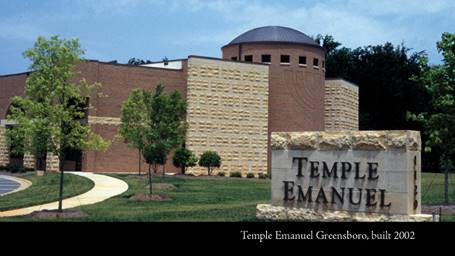A beyerdynamic Case Study: Temple Emanuel's Hybrid Meeting Model
During the pandemic, Temple Emanuel had to discontinue in-person services for its community, but the synagogue was able to continue providing spiritual support virtually. Now that pandemic rules are less strict, the temple has embraced a hybrid model of weekly Torah study, where some members meet with the rabbi in person while others connect virtually, enabled in part by beyerdynamic’s Phonum wireless Bluetooth speakerphone.

Like many industries and businesses across the country, religious groups struggled to meet during the pandemic. Especially now that it seems like COVID-19 isn’t going anywhere, groups of all types are beginning to realize that hybrid attendance models are a new normal. The group at the focus of this case study is a Jewish community in North Carolina; these individuals have been dedicated to the continuing of tradition, even amidst national unrest and uncertainty.
beyerdynamic was introduced to this Jewish community with a solution that impressed its congregation and rabbi far more than expected.
Located in Greensboro, North Carolina, Temple Emanuel is a diverse, 600-family Reform synagogue. This Jewish community explores Jewish traditions in an inclusive and relevant environment. During the pandemic, Temple Emanuel stopped holding Shabbat and other services for the community. Much like other faith communities across the country, Temple Emanuel discontinued in-person services but continued to provide spiritual support through virtual means.
Now that COVID-19 seems to be a lasting hurdle, Temple Emanuel has adopted a hybrid model. Some of the community’s members meet with the rabbi in person each week, while others connect in through video and audio.
This community of faith had been meeting in a classroom with a rectangular seating arrangement. At the beginning of the pandemic, Saturday morning Torah study, Chevrah Torah, was held online via Zoom. As COVID restrictions eased up, the hybrid model was conceived; however, it proved difficult to find a technological solution that allowed everyone to hear and see each other. In addition, the rabbi would use a whiteboard from time to time, explaining concepts and writing down notes for the attendees.
Rabbi Andy Koren leads Chevra Torah and is already using a laptop computer for notes, projection, Zoom connection, and more; the technology for wireless or USB connection was already present and available. This was one of the main reasons that the specific product was suggested.
The main problem that Temple Emanuel had with the hybrid model was that the Zoom attendees couldn’t hear the in-person attendees. The only microphone was on Rabbi Andy’s laptop; every comment by someone there had to be repeated, and this just wasn’t working well.
A daily selection of features, industry news, and analysis for AV/IT professionals. Sign up below.
In fact, the setup that the client required lent itself very well to a specific product; there was little need for different product testing or heavily relying on technical specs.
beyerdynamic has a long-standing reputation for being one of the best names in the audio industry. In a closed room with 10 feet from the recording device to attendees, the technology used for audio capture must be not only sensitive enough for distance but also have the capability to minimize the volume of closer interactions with the device. beyerdynamic was a clear choice due to their recording devices’ Gecko 360-degree technology. This technology performs extremely well on the selected device due to it having multiple microphones integrated into the design.
The beyerdynamic Phonum was selected as the product best suited to fit the client’s needs. Considering how other options would require wiring the entire room for capture and audio playback, the Phonum was an affordable alternative for a community of faith whose budget is better allocated to other areas. At a very moderate $219, the Phonum really is the best, most efficient tool for conference calls, hybrid meetings, and more.
The Phonum is very easy to install and charge--the unit itself has a rechargeable battery and the connections are made via Bluetooth. The device can connect to any computer, smartphone, or via USB. The Phonum also has its own audio output through a premium speaker; there’s no need to hook the device up to any external speakers if you don’t want to--and Temple Emanuel did not. “The mic/speaker was easy to install and immediately solved our problems without any complications. We have never had to use technical support,” said Rabbi Andy Koren.
Rabbi Andy put a stool in the middle of the classroom and set the device to Beam Forming mode. While the device was being initially set up, Zoom attendees could hear the beyerdynamic representative, Steve Taub of Taub Sales, while he was further than 10 feet from the Phonum, even with his head turned to the side while speaking. Taub was also heard at 10 feet without raising his voice at all.
The Chevrah Torah group noticed that anything more than 15 feet tends to diminish in volume. At this distance, it’s best to have attendees raise their voices a bit; however, Temple Emanuel’s Torah study group found that they raised their voices at this distance just so that everyone in the in-person classroom could hear each other.
“Above all, even though we are physically in different places, Phonum allows us to seamlessly be ‘socially together’ and to continue our great Shabbat morning Torah study class,” said Rabbi Koren. “We highly recommend this to other religious communities.”
The AVNetwork staff are storytellers focused on the professional audiovisual and technology industry. Their mission is to keep readers up-to-date on the latest AV/IT industry and product news, emerging trends, and inspiring installations.
